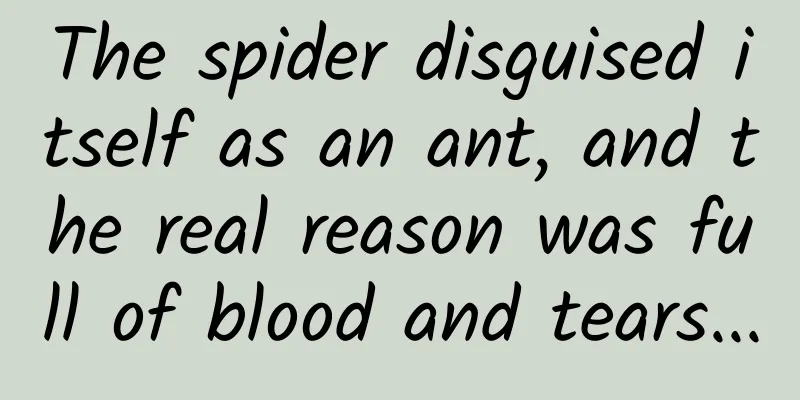The spider disguised itself as an ant, and the real reason was full of blood and tears...

|
When you think of spiders, what comes to mind? Is it the beautiful spider web under the eaves? Or the spider catching its prey with its fangs and claws? In nature, spiders are almost all predators, and of course they are also preyed on by other creatures. In order to better capture prey and escape from predators, some spiders become less like what people think they look like, and instead, more like ants! A spider disguised as an ant. Image credit: Ant misbehavin' yogendra174 Ant-like behavior: in nature "Spider's Thoughts" This behavior of spiders imitating the appearance of ants is called myrmecomorphy . More than 300 species of spiders are known to imitate the appearance of ants. Is this beyond everyone's expectations? Although ants and spiders both belong to the Arthropoda phylum, ants belong to the Insecta class, Hymenoptera order, while spiders belong to the Chelicerata subphylum, Arachnida class, Araneae order. Their body structures are completely different: ants have the typical three segments of insects, head, thorax and abdomen, and six legs; spiders have only two segments, head, thorax and abdomen, and eight legs. Ant-mimicking spiders and ants mimicked by spiders. Image source: theconversation The biggest morphological difference between ants and spiders is the composition of their bodies . Three certainly doesn't equal two, so in order to look like an ant, most ant-mimicking spiders have a "false waist" and some areas of their abdomens are covered with reflective hairs, making them look like they have three body segments. Not only that, but ant-mimicking spiders also have colored patches around their eyes, making their simple eyes look more like the compound eyes of ants. In addition to their appearance, Myrmecophaga spiders also behave like ants , with their front pair of legs waving like antennae in an erratic zigzag motion pattern near their heads. In general, the ant-like spider is a spider wearing an ant's coat and behaving like an ant. To sum it up in one word, it is "spider thinking and ant tracking." Catching and escaping predators: the magical uses of ants As mentioned earlier, spiders are natural hunters, but there are many other predators that feed on them. Therefore, spiders' ant-like behavior has two main functions: to deceive their prey and facilitate their hunting; and to deceive their natural enemies and make them lose interest in them. Next, let’s further understand the amazing behavior of this spider from the two perspectives of facilitating foraging and escaping natural enemies . Although most ants are small in size, this does not prevent them from being dangerous prey in the eyes of spiders. After all, ants are also covered in "heavy armor". Some species of ants have huge jaws and are poisonous. The most terrifying thing is that most ants tend to move in groups, so hunting them means facing a one-vs-many situation. But when the spider puts on a layer of camouflage, the results are very different. After a lot of observations, scientists have summarized the behavior of ant-like spiders in hunting ants: ant-like spiders usually jump onto an unsuspecting lone ant and inject venom to bite the ant to death. Then, in order to avoid being discovered by other ants, the ant-like spider will block the dead prey in front of it as a shield to deceive its companion ants , making the ants believe that the ant-like spider is also their own kind, thus allowing the spider to take the prey away. The role of ant-like behavior in spider hunting. Image source: References The spiders' ant-like appearance undoubtedly makes their prey less vigilant, while also allowing them to safely carry their prey back to their nests without being spotted by the ants along the way. In addition to finding food, mimicry can also help spiders escape the clutches of natural enemies . This type of ant-like behavior is a form of Batesian mimicry, which is characterized by a harmless species benefiting from mimicking a harmful species. In the eyes of spiders, ants are difficult prey, so some spiders disguise themselves as ants to deceive other spiders that are larger than themselves. The most famous example of Bates' mimicry is the jumping spider. Many smaller species within the genus Salticosa have mastered the skills of mimicking ants. This is because the big guys in the same genus do not show brotherly respect to these tiny creatures. Most of the time, the large jumping spiders bite them and treat them as their delicious meal. Some scientists have found that when an ant, a jumping spider that imitates an ant, a jumping spider that does not imitate an ant, and a large jumping spider are placed together, the large jumping spider's priority targets are mostly small jumping spiders that are not camouflaged. A jumping spider that mimics an ant. Image source: References So spiders sometimes disguise themselves as ants just to escape from the mouths of their own kind . It is not necessary to imitate, "Spider Fake Ant Power" It is also an option Having talked so much about spiders that imitate ants, there is actually another type of spider in nature that does not imitate ants directly, but they will "persuade" their natural enemies to retreat by becoming neighbors with ants, making full use of the "spider imitating ant power". In nature, there is a kind of spider called the flower-skin spider. They are very good at hunting. When the prey enters their hunting range, they will spray a ball of poisonous mucus from their head, which can trap and paralyze the prey . The flower-reed spider is hunting other spiders. Image source: References This spider is also a favorite prey of jumping spiders, and the flower-reed spiders usually build their webs above the jumping spiders' nests, carefully positioning them to ensure a direct hit on their targets. To escape the predators of the flower-dressed spiders, jumping spiders seek shelter in ants, whose social and territorial nature makes them attractive defenders to jumping spiders. In this case, the jumping spiders are not mimicking ants, but are simply taking advantage of the deterrent effect of ants. It turns out that if a jumping spider's nest is built near a weaver ant's nest, the flower-dressed spider will stay away because the chemical signals released by the ants keep the flower-dressed spider away. Therefore, the presence of an ant nest tends to encourage jumping spiders to build nests nearby. Although size matters in nature, the story of the spider and the ant shows us that unity and wisdom can trump sheer force . Whether it’s “spider thinking and ant tracking” or “spider imitating ant power”, nature always brings us some surprises and unexpected things, doesn’t it? References: [1]Cushing, PE (2012). Spider-ant associations: an updated review of myrmecomorphy, myrmecophily, and myrmecophagy in spiders. Psyche, 2012. Pekár, S., & KŘÁL, J. (2002). Mimicry complex in two central European zodariid spiders (Araneae: Zodariidae): how Zodarion deceives ants. Biological Journal of the Linnean Society, 75(4), 517-532. [2] Huang, JN, Cheng, RC, Li, D., & Tso, IM (2011). Salticid predation as one potential driving force of ant mimicry in jumping spiders. Proceedings of the Royal Society B: Biological Sciences, 278(1710), 1356-1364. [3] Li, D., Jackson, RR, & Barrion, AT (1999). Parental and predatory behavior of Scytodes sp., an araneophagic spitting spider (Araneae: Scytodidae) from the Philippines. Journal of Zoology, 247(3), 293-310. Produced by: Science Popularization China Author: EVEE (School of Life Sciences, Peking University) Producer: China Science Expo Submitted by: Computer Information Network Center, Chinese Academy of Sciences The cover image and the images in this article are from the copyright library Reproduction of image content is not authorized |
<<: Can ginger, Polygonum multiflorum and black sesame really help grow dark hair?
>>: Abnormal tumor markers ≠ cancer, find out in 3 minutes!
Recommend
Learn how to place Zhihu information flow ads in one article!
Today I decided to use this article to talk about...
Carbon monoxide poisoning season is here! Are you still making these mistakes?
Winter is the peak season for carbon monoxide poi...
Can the “South-to-North Water Diversion Project” overhead solve the “top priority” of the post-90s generation once and for all?
More than 250 million people in my country suffer...
Electric Technology Car News: With its stunning appearance and low price, can Trumpchi GS3 successfully enter the small SUV market?
GAC Trumpchi has been very successful in the SUV ...
Changing life: Samsung/Xiaomi/NFC-SIM bus swiping experience
On December 19, Samsung SAMSUNG Pay finally suppo...
A brand marketing program operation manual
This is a brand marketing operation manual that I...
How much does it cost for a Fuzhou merchant to become an agent for a grain and oil mini app?
How much does it cost to be an agent for a grain ...
Why hasn't BAT taken over the big fat piece of community O2O? There are too many hidden rules!
[[157017]] The community O2O market has been very...
"Wuwei Investment Course" Fu Gang established a stable and profitable trading system
"Wuwei Investment Course" Fu Gang estab...
Don't buy this kind of New Year flowers! It's illegal and poisonous
Review expert: Hu Jiayu, Master of Botany, Univer...
Apple app developers are developing new software to avoid the "Apple tax"
Beijing time, October 8, noon news, it is reporte...
How convenient would it be to use robots to take care of you after retirement?
On September 13, the decision to gradually delay ...
Qin Score Mini Program Development Function, Which Qin Score Mini Program Development Company is Best?
Many people cannot express their love for music i...
Control the 5 stages of app marketing, how to promote apps, how to promote apps, and steps to promote apps
1. Overall Logic There is only one logic in runni...
Is it expensive to join the Hami Underwear Mini Program? Hami Underwear Mini Program Franchise Fees and Process
For entrepreneurs, although mini program developm...









